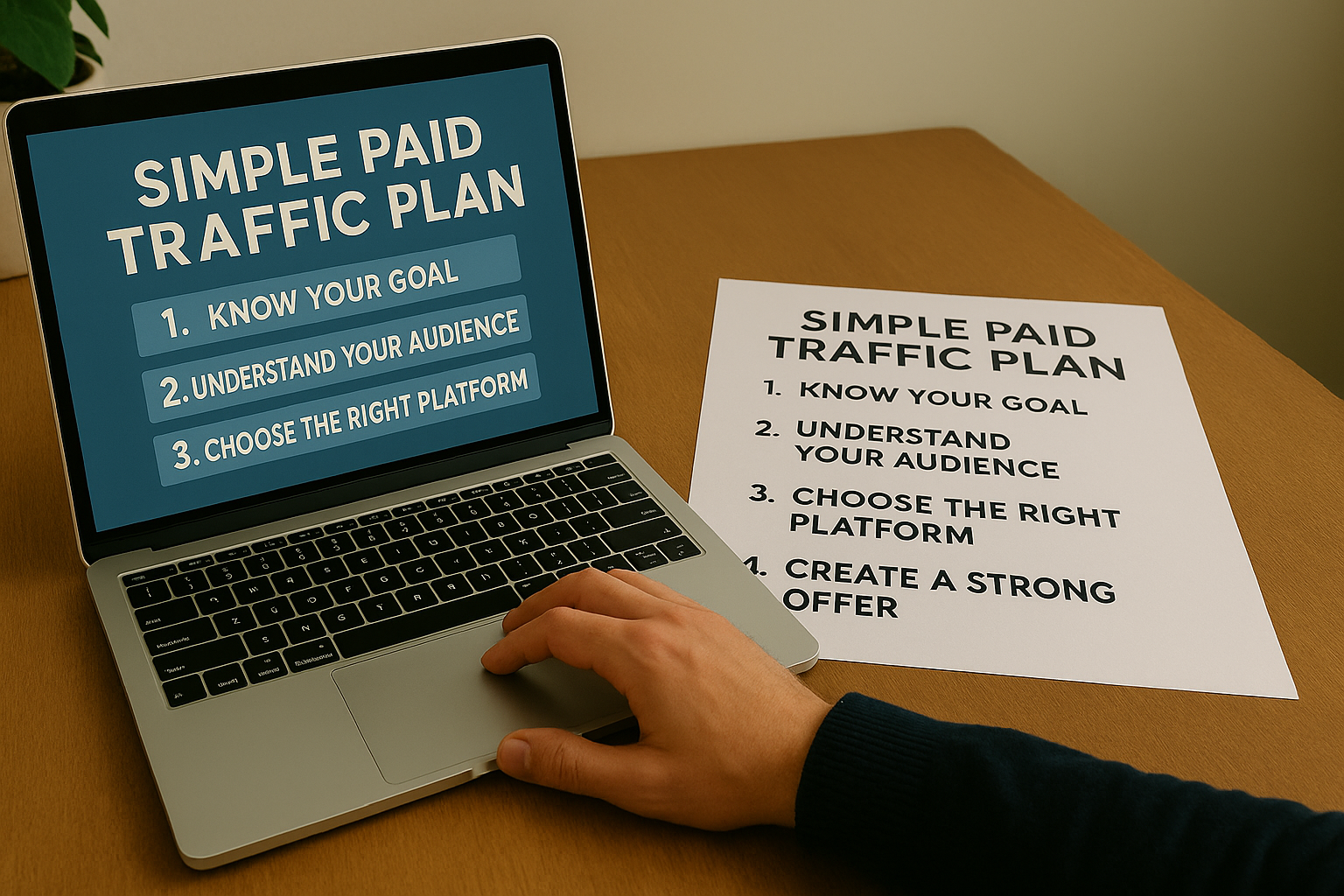Starting a paid traffic strategy can feel overwhelming — but it doesn’t have to be. Whether you’re a beginner or just trying to organize your ideas, this article will guide you step-by-step to build a simple and effective paid traffic plan that really works.
You don’t need a huge budget or fancy tools — just a clear goal, the right setup, and the willingness to test and learn as you go.
Let’s dive in.
Step 1: Know Your Goal
Before spending any money, you need to be 100% sure about your goal. Ask yourself:
- What do I want people to do when they visit my site?
- Am I trying to get sales, leads, email signups, or just visits?
Clear goals might look like:
- “I want 100 people to sign up for my free ebook this week.”
- “I want to sell 10 digital products this month.”
- “I want more people to read my blog and stay longer.”
Once you know your goal, everything else becomes easier.
Step 2: Understand Your Audience
You must know who you’re trying to reach. The more specific, the better.
Here are some questions to ask:
- What is their age group?
- Where do they live?
- What are their interests?
- What problems do they have that I can solve?
- Where do they spend time online?
Example:
Let’s say you sell fitness programs for new moms. Your audience might be:
- Women, aged 25–40
- Interested in post-pregnancy workouts
- Using Facebook, Instagram, and YouTube
- Searching for ways to lose weight safely after birth
Step 3: Choose the Right Platform
Not all ads work everywhere. You need to pick the platform that matches your audience.
Here are common choices:
| Platform | Best For |
|---|---|
| Google Ads | Reaching people who are searching for something now |
| Facebook Ads | Targeting based on interests and behaviors |
| Instagram Ads | Visual content and lifestyle audiences |
| YouTube Ads | Telling a story through short videos |
| TikTok Ads | Younger, mobile-first audience with fun content |
You can start with just one platform — the one your audience uses the most.
Step 4: Create a Strong Offer
An ad by itself won’t do much unless your offer is clear and appealing.
Think of what value you’re giving to people. Your offer should be:
- Simple
- Specific
- Easy to understand
- Focused on solving a problem
Examples of good offers:
- “Get a free 5-day workout challenge for new moms.”
- “Download our free guide to stop stress eating.”
- “Try our 7-day meditation app trial for $1.”
Step 5: Build a Landing Page That Works
A landing page is where people go after clicking your ad.
Good landing pages:
- Match the ad message perfectly
- Have no distractions (no menus or sidebars)
- Have a clear headline and call-to-action
- Load fast and work on mobile
A strong landing page can double your results — or more!
Step 6: Set Up Tracking
Before running your ad, make sure you can track results.
Tools you’ll need:
- Google Analytics (to track visits and behavior)
- Meta Pixel (for Facebook and Instagram)
- Google Tag Manager (helps manage other tracking tools)
- UTM Links (help you track different ad versions)
This helps you answer questions like:
- Which ad got the most clicks?
- Which campaign brought the most sales?
- Where are people dropping off?
Step 7: Create Your Ad
Now it’s time to make the actual ad. Keep it simple and focused.
A good ad includes:
- Image or video: Eye-catching and related to your offer
- Headline: Clear and benefit-driven
- Text: Short and helpful, explaining the value
- Call to action: “Download now,” “Learn more,” “Sign up free”
Test different versions of the ad to see what works best. You don’t need to be perfect — just keep trying and improving.
Step 8: Set a Budget and Schedule
Start small. $5–$10 per day is fine in the beginning.
Choose:
- Daily or lifetime budget
- Start and end dates
- Target audience details
Then, launch your campaign and watch what happens!
Step 9: Monitor, Learn, and Improve
After launching, check on your ad daily (or at least a few times a week).
Look for:
- Click-through rate (CTR)
- Cost per click (CPC)
- Conversions (sign-ups, sales, etc.)
- Return on ad spend (ROAS)
Pause ads that don’t work. Keep the ones that do. Try new versions often.
Step 10: Scale What Works
Once you find a winning ad, you can:
- Increase the budget
- Duplicate it for new audiences
- Try it on other platforms
- Turn the campaign into a long-term funnel
Small success leads to big growth when you keep testing and improving.
Common Mistakes to Avoid
- Starting without a clear goal
- Sending people to your homepage instead of a focused landing page
- Not tracking your results
- Spending too much too soon
- Giving up too quickly (testing takes time!)
Final Thoughts
Creating a paid traffic strategy from scratch doesn’t have to be scary. Just take it one step at a time:
- Set a clear goal
- Understand your audience
- Pick the right platform
- Build a strong offer
- Set up a good landing page
- Track everything
- Launch small, learn fast, and grow
With patience and smart testing, paid traffic can become one of your best tools to grow your business or blog.
